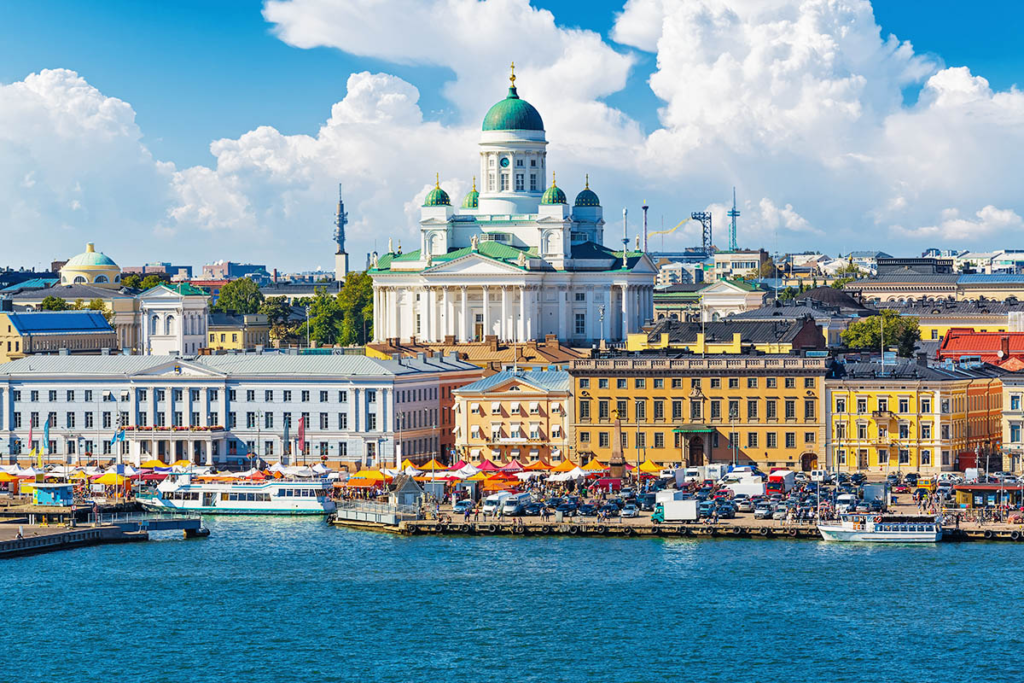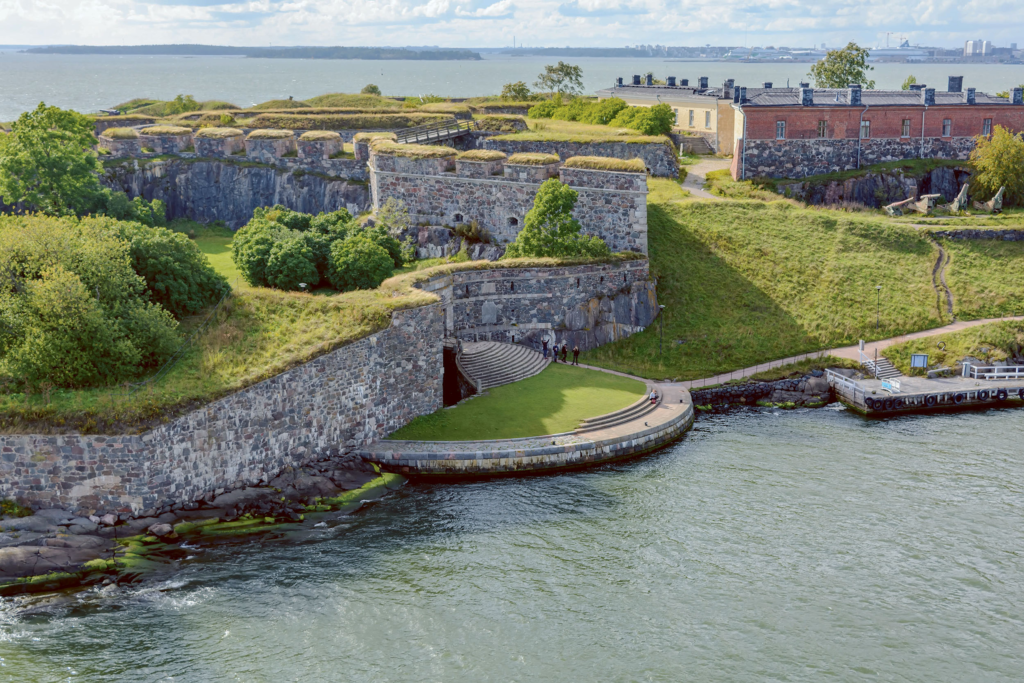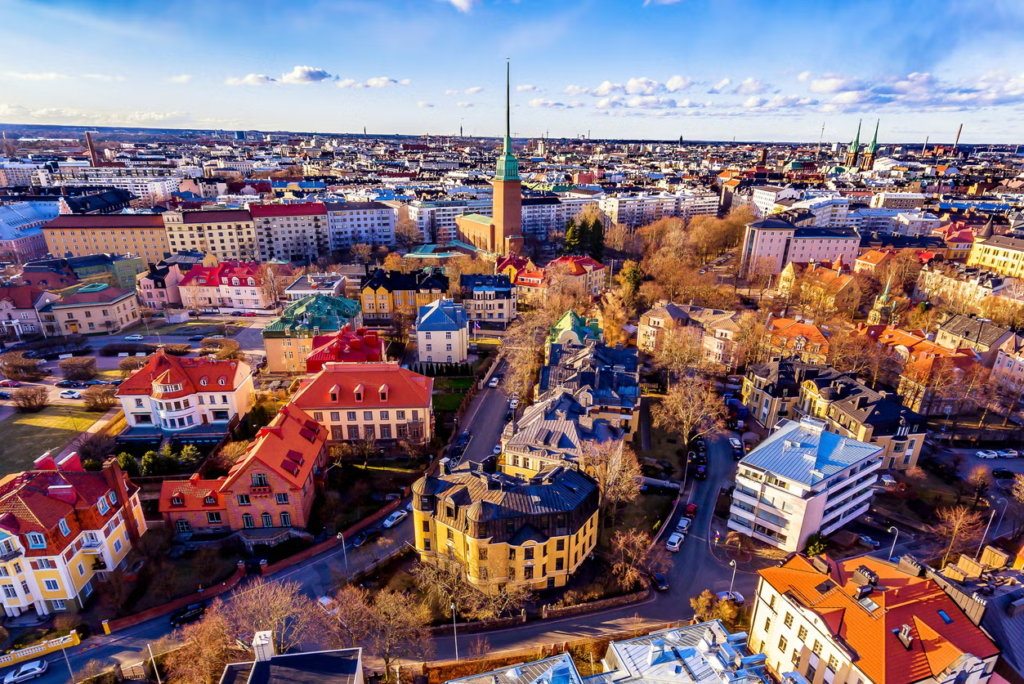Helsinki, Finland’s charming capital, has established itself as a global leader in sustainable tourism. From its eco-conscious initiatives to a strong commitment to preserving nature, the city combines modern innovation with a profound respect for the environment.
Its goal is simple: to offer tourists an authentic experience without compromising the city’s commitment to sustainability. In recent years, the city has been lauded for pioneering efforts in green energy, eco-friendly infrastructure, and public transportation. As more travelers seek destinations that align with environmental values, Helsinki stands out as a place where sustainability and a rich cultural experience meet.
Green Energy and Renewable Initiatives
One of Helsinki’s most impressive commitments is to renewable energy. The city has established ambitious goals to reduce its carbon footprint, pledging to become carbon-neutral by 2035. the city is leading the way in renewable energy, particularly with wind power and biomass as alternatives to traditional fossil fuels.
Many city buildings are powered by renewable sources, and the local government continually invests in developing energy-efficient infrastructures, such as green rooftops and solar-powered stations.
Read : Finland: The Enchanting Land of a Thousand Lakes and Captivating Midnight Sun
Helsinki’s dedication to green energy is also apparent in its use of district heating, which heats over 90% of the city’s buildings. This system captures waste heat from energy production and redistributes it to households and businesses, maximizing energy efficiency and significantly reducing the carbon footprint.
Read : Overdue Book Returned After 84 Years to Helsinki Library
These innovative approaches are part of Helsinki’s broader strategy to meet its carbon neutrality targets, setting a high standard for other cities to follow.
Eco-Friendly Public Transportation
Helsinki has created a public transportation system that prioritizes sustainability. With an extensive network of buses, trams, trains, and ferries, the city makes it easy for residents and visitors to travel without relying on cars.
The public transportation system in the city is powered by renewable energy sources, further minimizing environmental impact. The Helsinki Region Transport Authority has invested in electric buses and aims to make the entire bus fleet emission-free by 2025.
One standout feature of Helsinki’s transportation network is its commitment to integrated mobility. The city’s “Mobility as a Service” (MaaS) concept, accessed through the Whim app, combines multiple modes of transport into a single app.

This allows travelers to plan routes using trams, bikes, car-sharing, and taxis, all while reducing carbon emissions by encouraging public transit use. the city approach not only makes travel convenient but also fosters sustainable choices that align with the city’s environmental goals.
Cycling and Walking Infrastructure
Helsinki’s infrastructure is designed to encourage cycling and walking, making it one of the most bike-friendly cities in the world. With over 1,300 kilometers of bike lanes, the city offers cyclists safe and extensive routes throughout the city.
Many roads and streets have been redesigned to prioritize pedestrians and cyclists, creating a harmonious balance between modern transport needs and sustainable practices.
To further promote eco-friendly travel, the city has also implemented bike-sharing programs, such as City Bikes, which provides an affordable and accessible way to get around. This service operates between May and October, with a fleet of thousands of bikes available at docking stations across the city.
Additionally, the city has embraced pedestrian-only zones in key areas, encouraging visitors to explore its vibrant neighborhoods on foot while reducing traffic congestion and air pollution.
Sustainable Architecture and Green Spaces
Helsinki’s urban landscape reflects its commitment to sustainability. The city is home to numerous eco-friendly buildings designed with energy efficiency in mind. Architects in the city prioritize materials that reduce energy consumption, such as recycled wood and sustainable concrete.
One prominent example is the Helsinki Central Library Oodi, an architectural masterpiece built with sustainable materials, energy-efficient systems, and even features a green rooftop terrace.
Helsinki has also preserved ample green spaces, with parks, nature reserves, and waterfronts easily accessible within city limits. Central Park, one of Helsinki’s largest green areas, is a haven for locals and tourists alike, offering trails for hiking, jogging, and biking.

The city’s green areas provide residents with access to nature and contribute to air quality and biodiversity. In the city, urban development and environmental preservation are equally valued, resulting in a city where nature thrives alongside modernity.
Sustainable Dining and Local Food Scene
The culinary scene in the city is increasingly embracing sustainability. Many restaurants have adopted farm-to-table principles, sourcing ingredients locally to reduce carbon footprints. The city’s chefs often work closely with local farmers, fishers, and foragers to bring seasonal, fresh, and sustainably produced food to the table.
By emphasizing local flavors and reducing reliance on imported ingredients, Helsinki’s restaurants help minimize transportation emissions and promote regional biodiversity.
One popular dining trend in the city rise of plant-based menus. Many eateries offer vegan and vegetarian options, contributing to a lower environmental impact. The Helsinki Food Market, for instance, is a vibrant space where visitors can sample a variety of local and eco-friendly foods, showcasing the city’s dedication to sustainable dining.
Helsinki’s culinary landscape not only offers delicious cuisine but also encourages mindful consumption, aligning with the city’s values of environmental stewardship.
Community Involvement and Education
Sustainability in the city is not solely driven by government policies; community involvement plays a significant role. Environmental awareness is deeply ingrained in Finnish culture, and the city regularly organizes events to educate residents and tourists on sustainable practices.
Initiatives such as “Helsinki Day” bring together locals and visitors for environmental workshops, clean-up activities, and sustainability awareness campaigns.

The city’s residents actively participate in recycling programs and waste reduction initiatives, with recycling stations conveniently located throughout the city. Furthermore, Helsinki’s schools include environmental education in their curriculum, ensuring that future generations understand the importance of protecting the planet.
The city’s commitment to community engagement has fostered a sense of collective responsibility, where every citizen contributes to a greener, more sustainable Helsinki.
Eco-Friendly Shopping and Local Crafts
For travelers interested in shopping sustainably, Helsinki offers an abundance of options. Local markets and boutiques emphasize handmade, ethically produced, and eco-friendly products, supporting Finland’s traditional crafts and sustainable fashion movement.
The city is home to numerous thrift shops and sustainable fashion brands, where visitors can find unique clothing and accessories that minimize environmental impact.
Helsinki also boasts artisanal markets like the Hakaniemi Market Hall, where locals sell organic produce, handmade crafts, and recycled items. These markets provide tourists with an opportunity to purchase authentic Finnish products that support the local economy and promote sustainability.
Shopping in Helsinki offers a meaningful experience that goes beyond consumerism, encouraging travelers to choose products that reflect the city’s values.
Responsible Tourism and Nature Conservation
Helsinki encourages responsible tourism by promoting eco-friendly activities and nature conservation efforts. The city is surrounded by natural beauty, including islands, forests, and lakes that offer visitors a peaceful escape from urban life.
Popular outdoor destinations like the Nuuksio National Park are carefully managed to ensure that tourism does not harm the ecosystem. Hiking, kayaking, and wildlife watching are popular activities that allow travelers to connect with nature while respecting the environment.

Helsinki’s tourism board actively promotes sustainable travel by providing guidelines on how visitors can reduce their impact. The city’s commitment to responsible tourism is part of a broader strategy to protect Finland’s pristine landscapes and ensure that future generations can enjoy the natural beauty that makes the city a unique destination.
Innovative Waste Management Practices
In Helsinki, waste management is an integral part of the city’s sustainability efforts. The city has developed efficient recycling systems to reduce landfill waste, with recycling bins for paper, plastic, glass, and metal located throughout the city.
Helsinki also utilizes waste-to-energy facilities, which convert waste materials into renewable energy for heating and electricity. This approach not only reduces the volume of waste but also provides a sustainable energy source for the city.
Additionally, Helsinki has introduced a smart waste collection system that optimizes waste pickup routes, reducing the carbon footprint of waste disposal trucks. The city’s comprehensive waste management strategy is designed to minimize environmental impact while maximizing resource efficiency, setting a model for other urban centers around the world.
Cultural Preservation and Heritage Sites
Helsinki’s sustainable approach extends to its cultural preservation efforts. The city is home to numerous historical sites, museums, and cultural landmarks that are carefully maintained to preserve Finnish heritage.
The UNESCO World Heritage Site of Suomenlinna, an 18th-century sea fortress, is a prime example of how Helsinki balances tourism with heritage preservation. The fortress is managed sustainably, with restrictions on visitor numbers to prevent overcrowding and protect the site’s historical significance.
Helsinki’s museums, such as the Finnish National Museum and the Ateneum Art Museum, also follow sustainable practices by incorporating energy-efficient lighting and environmentally friendly materials in their exhibitions. The city’s dedication to cultural preservation ensures that visitors can experience Finland’s rich history without compromising its commitment to sustainability.
Helsinki’s Vision for a Sustainable Future
Helsinki’s commitment to sustainability is not limited to the present; the city has a long-term vision for a greener future. The city government continually evaluates and updates its sustainability initiatives, ensuring that Helsinki remains a model for environmental responsibility.
This forward-thinking approach is evident in Helsinki’s participation in global initiatives such as the Carbon Neutral Cities Alliance, where it collaborates with other cities to develop innovative solutions for climate change.

Helsinki’s vision for the future also includes ongoing investment in green technologies, renewable energy, and sustainable urban development. By prioritizing sustainability in every aspect of city life, Helsinki is creating a model of urban living that minimizes environmental impact while enhancing the quality of life for its residents.
Helsinki is more than just a travel destination; it’s a testament to the power of sustainability in urban planning. With its commitment to renewable energy, eco-friendly transportation, green spaces, and community involvement, Helsinki has established itself as one of the world’s most sustainable cities.
Visitors to Helsinki can enjoy a unique experience that not only highlights Finland’s natural beauty and cultural heritage but also showcases a sustainable lifestyle that respects the environment.
Whether exploring its historic sites, dining at sustainable restaurants, or shopping for local crafts, tourists in Helsinki can experience a city that is dedicated to protecting the planet. Helsinki’s success as a sustainable travel destination is a beacon of hope for other cities, demonstrating that a balance between development and conservation is possible.
As the world increasingly embraces eco-conscious travel, Helsinki’s model of sustainability sets a new standard for responsible tourism, inviting travelers to explore a city that truly cares for the Earth.
let’s enjoy few years on earth with peace and happiness….✍🏼🙏

